Candy Corn
Ah, candy corn, perhaps the most controversial treat in the Halloween bag! Love ‘em or leave ‘em, this sugary little triangle has become a big part of our shared culture, even though its original inventors didn’t mean for it to become a seasonal favorite.
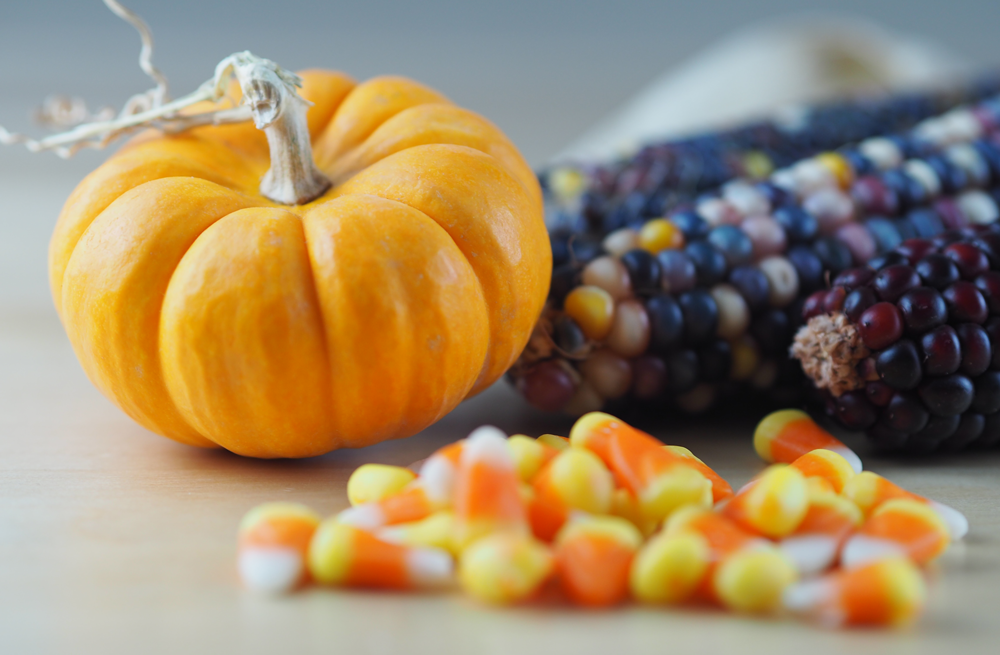
Once marketed year-round as a candy called ‘Chicken Feed’ it’s now a treat that most folks eat only once a year, a Halloween tradition stretching back almost 150 years. Enjoy our Sweet Poem tribute to a candy corn spouting broom, try your hand at making your own Candy Corn Art, and create a candy corn colored Density Tube to explore a yummy-looking (but not yummy tasting) science treat.
 A Sweet Poem
A Sweet Poem
One of our favorite things to do here at Kidspace is to get silly, whether it’s through goofy dance moves, good/bad puns, or poems that are fun to read out loud. This Halloween inspired poem featuring candy corn is nearly as much fun for your tongue as the candy itself.
Polka-Dot Witches
by Barbara Vance
Excerpt from “Suzie Bitner Was Afraid of the Drain”
Polka-dot witches
Ride wizzy-wig brooms
And streak ‘cross the moon
Trailing candy-corn plumes
Their hats glow with stars
They plucked from the sky
And their spider-web capes
Gather smiles as they fly
They’re the sparkliest,
Happiest witches in sight;
But they only come out
When it’s Halloween Night!
Reading poems, especially out loud, helps promote speech development and reading skills. As kids learn how to pronounce unique words and explore different ways to intonate and play with their voice through rhythmic patterns and rhyme, they are practicing skills such word formation and expanding phonemic awareness.
Pumping up the Poetry
- This poem integrates fun, thematic language that you can encourage your child to practice saying in creative, silly voices. By inviting your child to recite some of the words and phrases from the poem, you’re encouraging pre-literacy and oral language development.
- Draw a picture of what they think the poem may look like – or use it to inspire your own candy corn art, as seen in the next activity!
Candy Corn Art
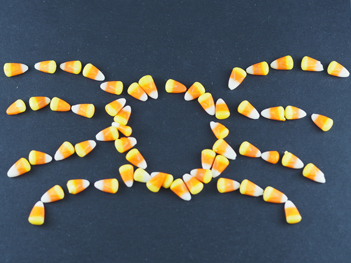 Using our video treat as inspiration, explore candy corn as a medium for creating pictures. Materials such as paint, pencils, and clay are excellent art-making tools, but it’s also fun to remember that almost any material can be used to create art.
Using our video treat as inspiration, explore candy corn as a medium for creating pictures. Materials such as paint, pencils, and clay are excellent art-making tools, but it’s also fun to remember that almost any material can be used to create art.
Besides the fun of using a treat as the medium, this project encourages kids to practice thinking flexibly about lines, texture, and space. A novel creative medium can also inspire different choices than they would make with markers or paints.
Supplies
- Candy Corn! Lots of it!
- Optional:
- Dish for the candy corn
- Tray or construction caper
- Construction or another kind of paper
- Glue (school glue works best for this project)
- Toothpicks
Directions
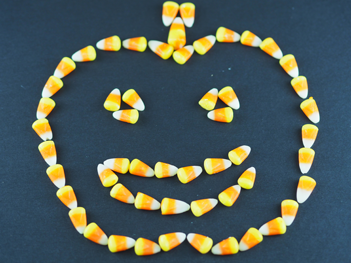 Give kids the supplies, and, if you like, take some of your own to work alongside them. This is a great hands-on activity that helps develop children’s fine motor skills and hand-eye coordination when they arrange the corn pieces, apply glue, place the candy corn, and so-on.
Give kids the supplies, and, if you like, take some of your own to work alongside them. This is a great hands-on activity that helps develop children’s fine motor skills and hand-eye coordination when they arrange the corn pieces, apply glue, place the candy corn, and so-on.
- Pumpkin
- Happy Jack-o’-lantern
- Sad Jack-o-lantern
- Spider
- Bat
- Candy car
- A big, BIG piece of candy corn!
- A family portrait
In addition to these images, try making different patterns, like
- A zig-zag
- Parallel lines
- A spiral
- Connected triangles
Shapes and creations can be flat two-dimensional reproductions, but you don’t need to stop there. If kids are interested, using toothpicks and glue to build three-dimensional art is great too!
 Amping up the Art
Amping up the Art
- Use the poem above to inspire creativity!
What might this poem look like, as illustrated with candy corn? - Integrate an engineering challenge.
What’s the tallest structure you can build with just candy corn and toothpicks?
Can you create a bridge?
What about a building? - Explore emotions.
What’s a happy shape, a sad shape, an angry shape, a tired shape?
What needs to change to move from one shape to another? - Practice counting.
How many pieces of candy corn did you use to make your art?
What’s the most interesting picture you can make with just ten pieces of candy corn?
What about eight? Six? Four?
Candy Corn Density Tube
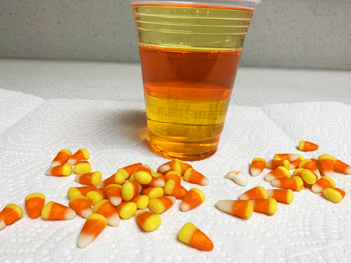 We’re not sure why, but a piece of candy corn would feel a lot less fun if it were just one color, wouldn’t it? In this activity, the distinctive layers of candy corn are used as an invitation to explore how layers might form. This project is great for practicing foundational science skills through making predictions, experimenting, observing to see what happens, and interpreting the results.
We’re not sure why, but a piece of candy corn would feel a lot less fun if it were just one color, wouldn’t it? In this activity, the distinctive layers of candy corn are used as an invitation to explore how layers might form. This project is great for practicing foundational science skills through making predictions, experimenting, observing to see what happens, and interpreting the results.
A quick refresher on density: Density is how much “stuff,” or matter, an object has, compared to its volume. Picture that you are carrying two boxes, one in each arm. The boxes are the exact same size, and each of them has the exact-same sized pieces of candy corn in them. The only difference is that in one box, the box in your left arm, has thousands of pieces of candy corn in it, so it is very heavy. The other box, the box in your right arm, only has a few pieces in it, and it’s very light. The heavy box is more dense, because it has more candy corn in it. The lighter box is less dense because it has fewer pieces of candy corn in it.
Got it? Let’s explore and experiment!
Supplies
- A tall clear jar or container
- Measuring cups
- Extra container to measure out liquids into
- 1 cup of water
- 1 cup of corn syrup
- 1 cup of vegetable oil (canola, peanut, or olive oil also work!)
- Food coloring (orange and yellow for the candy corn theme, although any colors are fine)
- Spoon
Directions
 Throughout this process, encourage your child to talk about what they think will happen before each liquid is added, then to carefully look closely to check their prediction! This helps practice some basic parts of the scientific process. As an added bonus, let them do the measuring to build on and support developing math skills!
Throughout this process, encourage your child to talk about what they think will happen before each liquid is added, then to carefully look closely to check their prediction! This helps practice some basic parts of the scientific process. As an added bonus, let them do the measuring to build on and support developing math skills!
- Measure out your cup of corn syrup and add 4-5 drops of yellow food coloring and mix until the corn syrup is a bright, vibrant yellow. Set aside.
- Measure out a cup of water and add 2-3 drops of yellow food coloring and 2-3 drops of red food coloring. Mix until the water is bright, vibrant orange. Set aside.
- Measure out one cup of oil. Set aside.
- Carefully pour your yellow corn syrup into the container.
- Next, gently pour your orange water into the container. To create the crisp layers try not to mix or disturb! (One old trick to try is to pour slowly over the back of a spoon held just above the layer below)
- Finally, pour the oil slowly into the container.
You should see three distinctive layers: Yellow corn syrup on the bottom, orange water in the middle, clear oil on the top! How did that work? The corn syrup is more dense than both water and oil and sinks to the bottom. Oil is less dense than both water and corn syrup, so it sits on the top. Water is denser than corn syrup but less dense than oil, which is why it stays in the middle.
Density Deviations
- Experiment and make predictions
- What might happen if we add the ingredients in the opposite order?
- What might happen if we shake or stir up the ingredients?
To view all our Halloween blogs and more, click here.
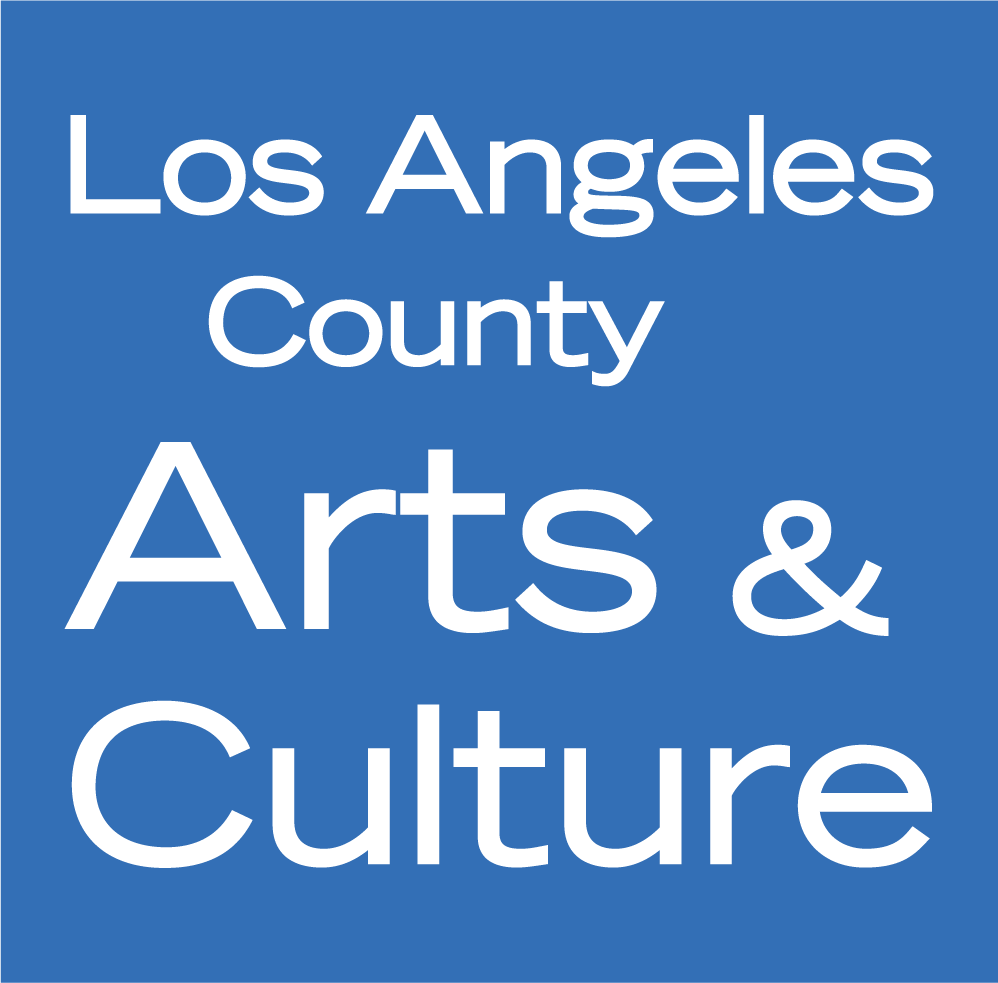 This program is supported, in part, by the Los Angeles County Board of Supervisors through the Los Angeles County Department of Arts and Culture.
This program is supported, in part, by the Los Angeles County Board of Supervisors through the Los Angeles County Department of Arts and Culture.
